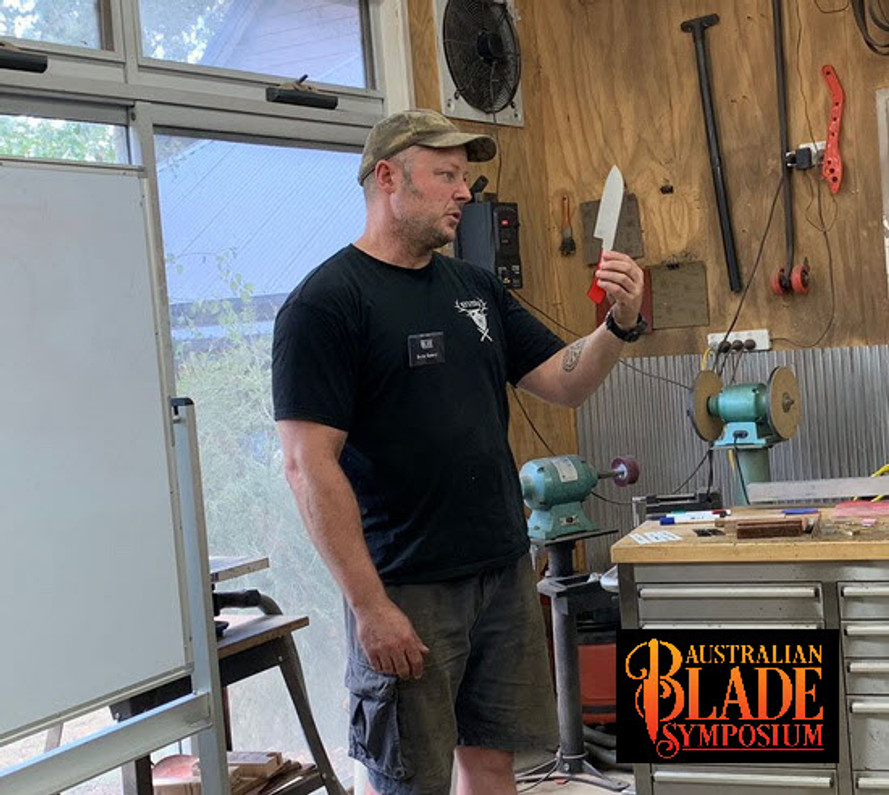2019 Blade Symposium
2019 Blade Symposium - A Noob's Journey
My first blade symposium began with leaving home at 2pm, collecting Bjorn from the city at 3pm, and sitting in traffic for more or less the next 5 hours. We arrived at Cuppacumbalong Homestead in the ACT in the dark, during the trailing end of a Q&A session after Rodrigo Sfreddo’s Opening Address of the symposium.
It was mildly disappointing to have missed the actual talk, but we were glad to be able to open a beer nevertheless, and figured he had 3 more session over the weekend we could see. Throwing our gear in the more-than-comfortable 5 person glamping tents provided, we made our way into the throng of black t-shirts, tattoos and beards.
We had missed dinner, but thankfully Karim rustled up some left-overs from the kitchen, so we sat with Mert Tansu and Bruce Beamish and toasted the weekend. The night wore on with talking and shenanigans until the bed wisely suggested turning in.
Saturday
During breakfast, discussions were had, and the highlighters were out to mark the preferred talks for the weekend.Being a noob to knife making, and sporting a shoulder injury that has put off any thoughts of forging for the next few months, I focussed on presentations revolving around knife design, grinding techniques, sharpening and surface finishes.
Session One: Rodrigo Sfreddo - “Knife Design”.
I guessed that this session might have been for the more advanced makers, based on the pictures of Rodrigo's knives I'd seen, but the opportunity to get into the mind of such a talent was not to be missed.
It’s fair to say that Rodrigo Sfreddo is a knife maker of exceptional skill and artistry, creating quite dazzling and beautiful knives with keyhole integrals (a technique he would cover in a later session) gold inlays, sweeping lines - simply wonderful craftsmanship.
It’s also fair to say the he isn’t quite as talented at departing any particularly useful information about knife design, to noobs at any rate…. nothing I could take notes for, anyway.
If that sounds like a attack about the session, it shouldn’t, really. I can’t account for how was briefed, and I can take into account a language barrier, and a possibly shy personality, but the fact i didn’t come away with pages of notes from a master didn’t detract at all from hearing was was talked about.
It was more a knife-porn slide show, that i’m pretty sure had the whole audience all at once leaking in positive appreciation, and slowly dying a little inside awn their own comparative ineptitude, as the slides continued.
The Take Away…? Damn, should have started making knives 30 years ago…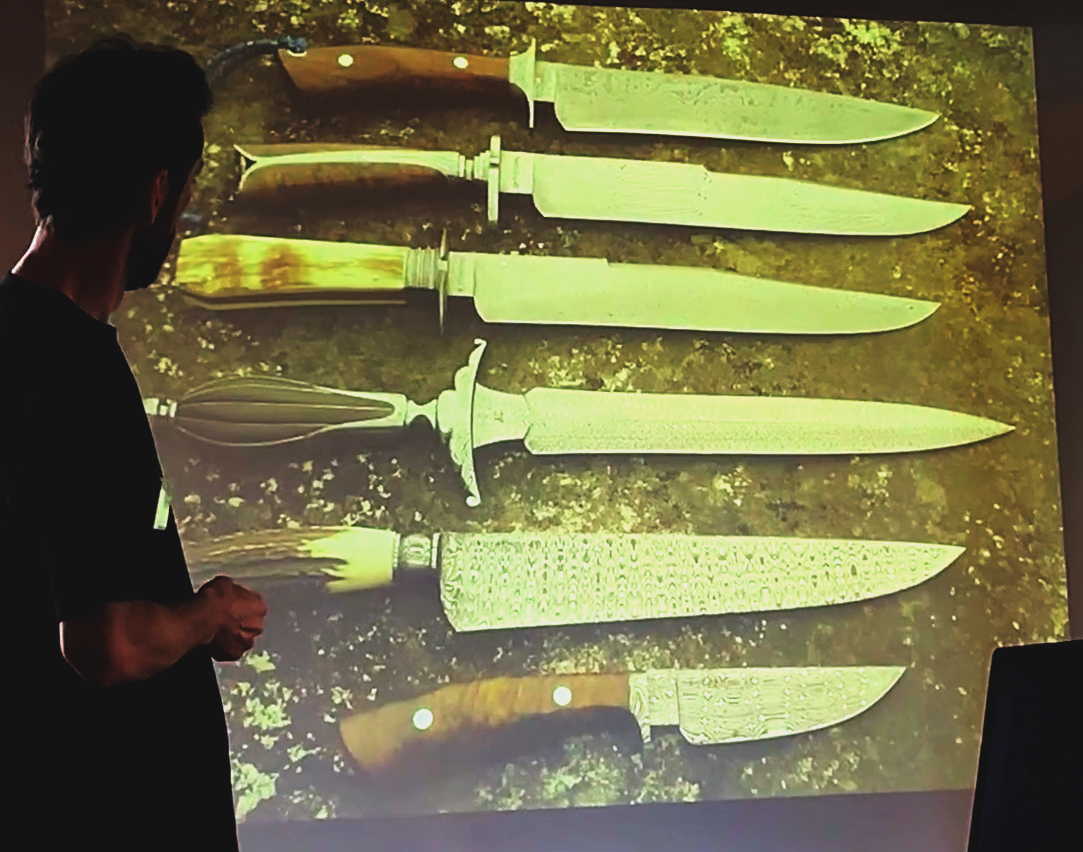 .
.
Rodrigo Sfreddo's knife porn.
Session 2: Mert Tansu - “Japanese Handle Making and Fitment”
I didn’t really have much idea about Japanese knives as such, so this seemed interesting. And it was.
What struck me most about this session was the benefits of streamlining a process, what ever it may be, if it’s going to be done repeatedly.
Mert uses perspex templates for many aspects of his japanese handles, which takes a hell a lot of the thought per/knife away. Templates for the blades them selves; templates to line up the dowel an the alignment pins; templates for each end of the handle, in what ever cross section design he wants (oval, D-shape, semi-oct, octagonal), as well as the side and top perspectives. The use of a little dremmel rotary saw to mark a tang-line reference prior to drilling the visible tang hole seems obvious now, but there were a few surprised faces in the room.
Needless to say, load more was covered, and i got a good few pages through my notepad.
The Take Away…? Templates can make things one hell of a lot simpler, and dowel down the centre of a hardwood handle does wonders for making a handle lighter...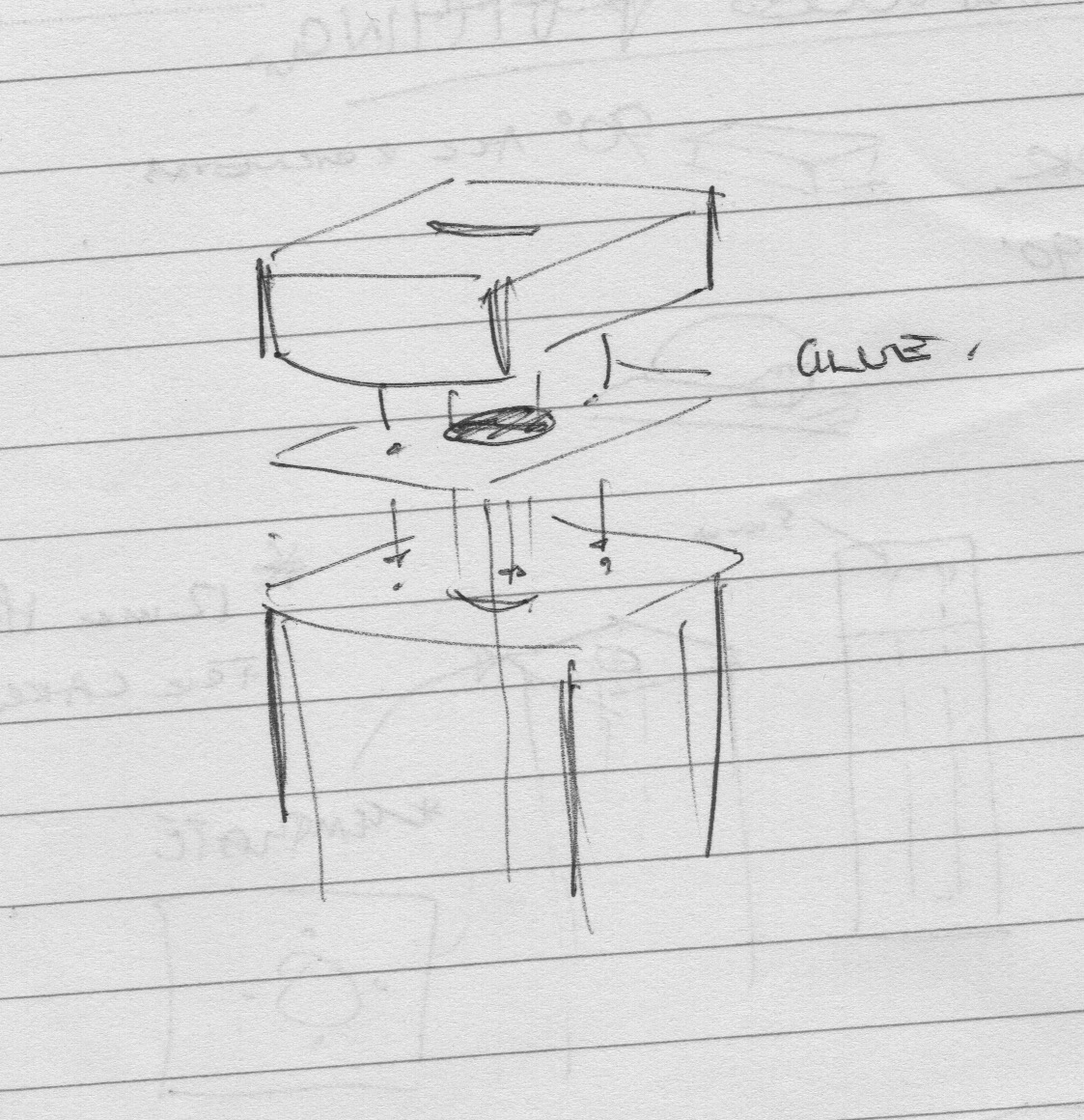
Scribble of handle fitting - no time to take a photo!
Session 3: Kev Slattery - “Intro to Handle Design”
In terms of design considerations in knife making, this session had the goods. The use of templates arose again - different templates for different knife styles and different handle styles - and had me wondering where my nearest perspex stockist was.
Guard dimensions and choice of guard material, lengths of riccasso, the relationships between them;
Handle lengths, use of french curves; tips for approaching the profiling of the handle; pin placement considerations were all covered, and again, many notes were taken.
The Take Away…? It's all about how it feels in your hand...

Kev's Handle Design
Session 4: Mert Tansu - “Sharpening”
With a cross section of a blade quickly drawn on the board, we were given the sage advice, “The pointy bit cuts. That’s sharp.” Sometimes, you just gotta start with the basics…I got a load out of this class. I won’t go into how i may or mayn’t have blasphemed in the past with my sharpening techniques - this is neither the time nor the place. But, again, having never researched it too much, there was a good few diagrams draw of finger placement, angles of blades relative to the stone, sweeping motions etc,… Choice of grit and knowing when it’s pointless to go an higher was also a nice bit of info.
The Take Away…? Keep them sharp.

Mert sharpening
Saturday night, they must have made a million pizzas to feed us all. The beer was flowing, and so, as they say in Ireland, was the craic. Eventually, though the exhaustion of one full day promised tomorrow would be as full, so it was back to the tent.
Sunday:
Session 1: Keith Fludder - “Grinding 101”
A really good, solid, session.
It essentially confirmed some suspicions I’d formed during grinding away at home - common mistakes; issues to look out for, and ways of dealing with them. Tips to approach getting your bevels even, some I’d worked out previously, others I hadn’t considered.
Keith covered a few options for bevel jigs, use of tool rest, using a file guide to ensure plunge lines match, marking the blade to match sides, how to flatten the blade - tang and bevels, and alternating grit direction on the disc sander, as you would hand sanding, to ensure scratches are kept to a minimum.
The Take Away…? Practice, practice, practice, 'til you don't even think about using a jig...
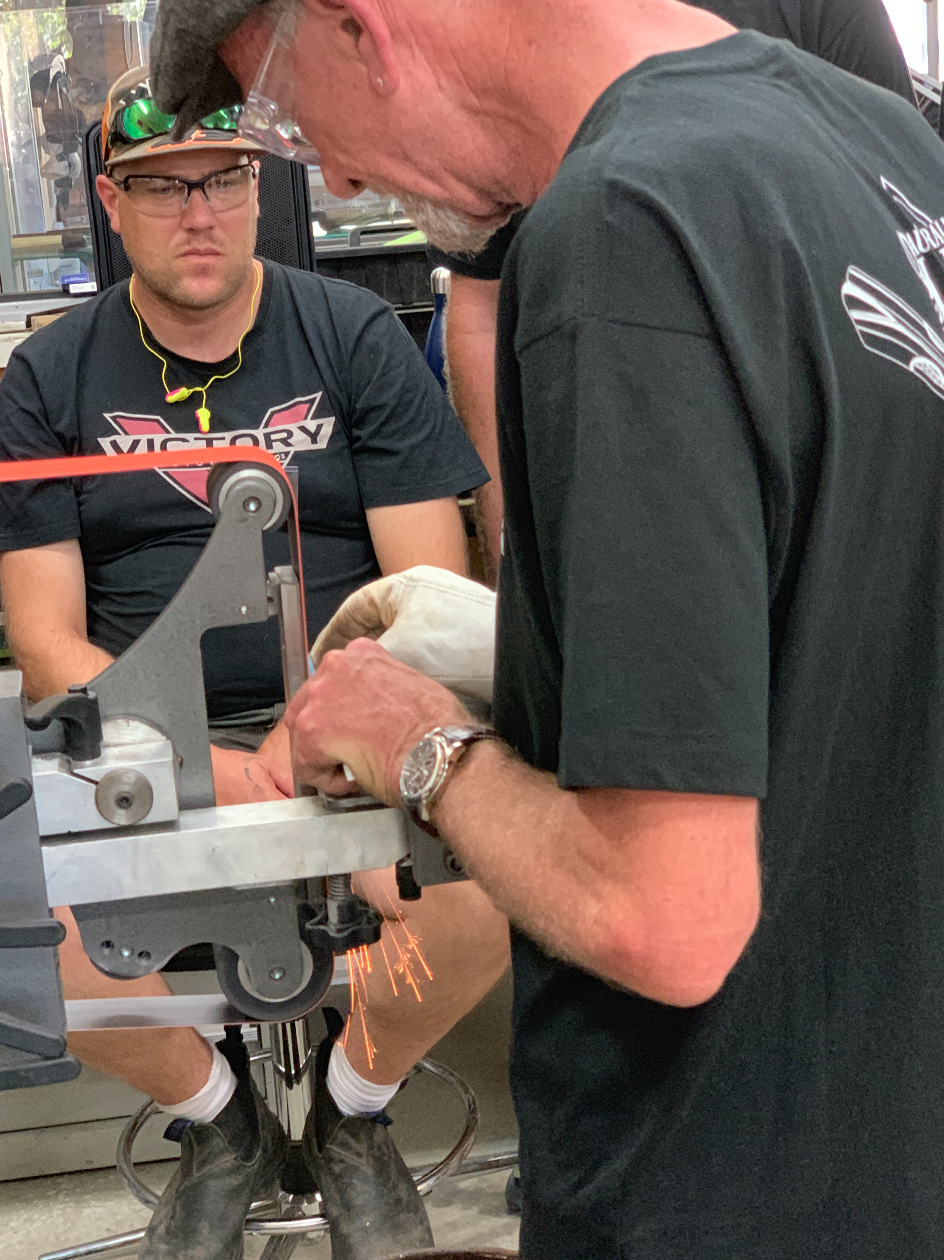
#UnkyKeif grinding
Session 2: Dmirty Popov - “Advanced grinding”
To be honest, I did't think this session really fit my level of experience, but, encouraged by the fact that most other sessions involved “forging” related topics, i went along to Advanced Grinding.
Dmitry began by briefly going though his own knife making journey, before delving into considerations that I wouldn’t have thought ‘fit’ the class, but ultimately make sense, and it was this aspect that made this the stand out class of the weekend for me.
Considerations such as: grinder height ( how close to your work are you?); your posture (you’ll be standing, doing this for a long time - lock elbows, proper supportive space etc ); bucket placement for dipping blade (you don’t want to have to come out of your proper posture continually just to dip a knife, so keep it close, and of the relevant side); get loads of light, all around you, different types too - led, halogen etc (the more light you have, the easier it is to see scratches, which will save you time and aggravation in the long run, but also different kinds of light will show up scratched surfaces a little differently… )
He covered sweeping plunge lines, compound grinds, hollow grinds, compound hollow grinds found on Japanese kitchen knives, swedges, tapered tangs, blade thickness in general, but also specifically kitchen knives - 0.005mm, incase you were wondering….
The Take Away…? Get your body and workshop set-up to get the most out of knife making over the long term, and practice the bejeezus out of grinding until your geometry is on-point...
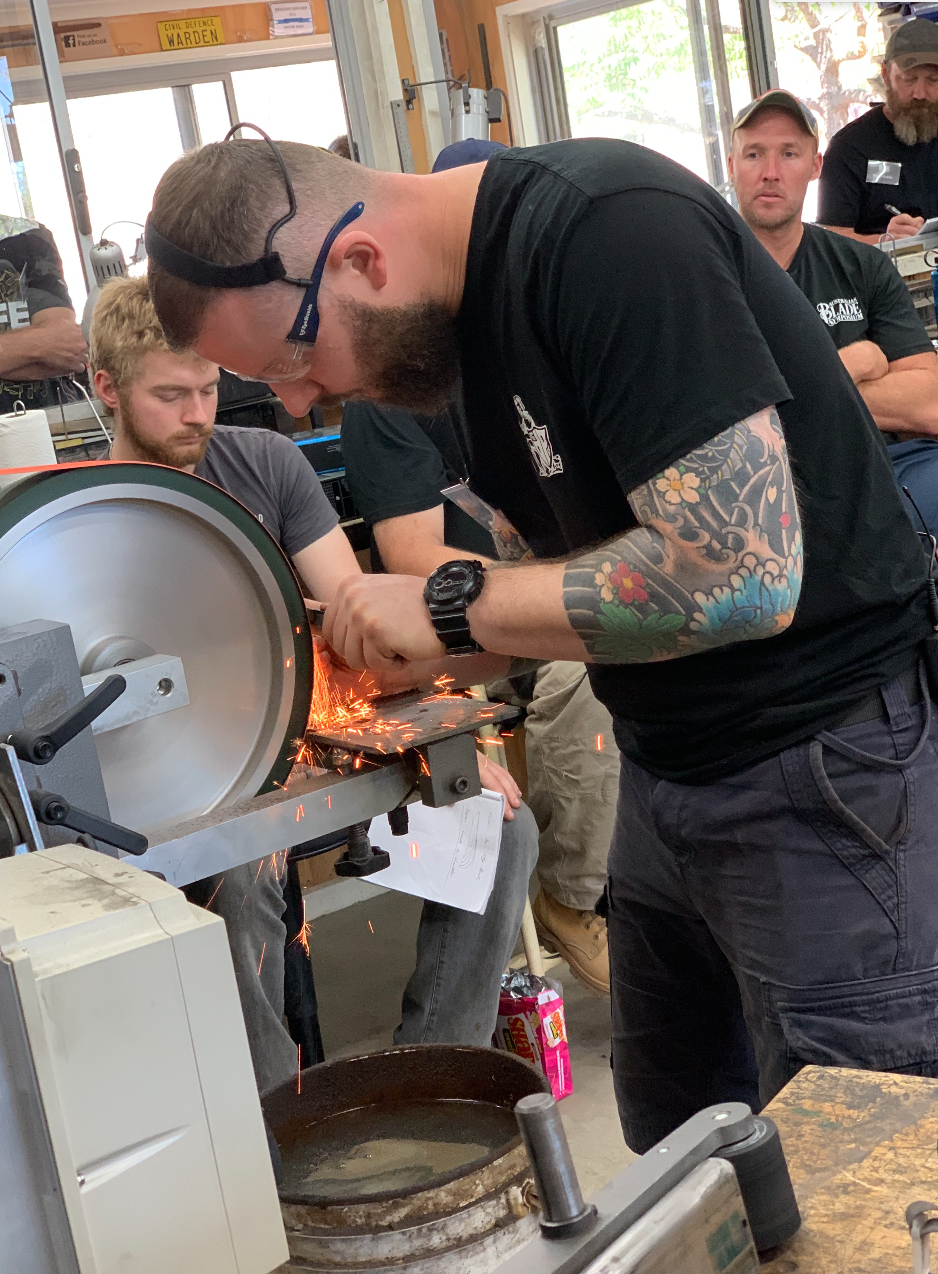
Dmirty's Advance Grinding
Session 3: Paul Arestan “Etching, Scrimshaw & Patina Finishes”
Paul class was the one i was probably most looking forward to. I have been a professional illustrator for about 10 years, and have dabbled in etching plates to print ink onto paper, but seeing Pauls etched blades a couple of years ago, made me wonder about how he does it, and how long it’d take before i’d be able to find out first hand how he does it. Question answered…
There was a lot to cover in this session. The equipment needed, and ratios of ferric chloride to water for the etchant, ratios of bitumen paint to turps for the resist, surface finish prior to etching were all covered, and then came the steps taken achieve the layered, three-dimensional look Paul gets. Multiple dips in the ferric, quick clean between, and pitfalls to avoid. Paul then explained how western Australian knifelike Jake Rhodes uses stencils instead of the bitumen pain as the resist to get his blades etched the way he does. The illustrator in me balked a little at this, questioning the artistic integrity of such an approach, but ultimately, we do whatever we need to to get the look we want, so why not…? In any event, i was googling vinyl cutters the next day.
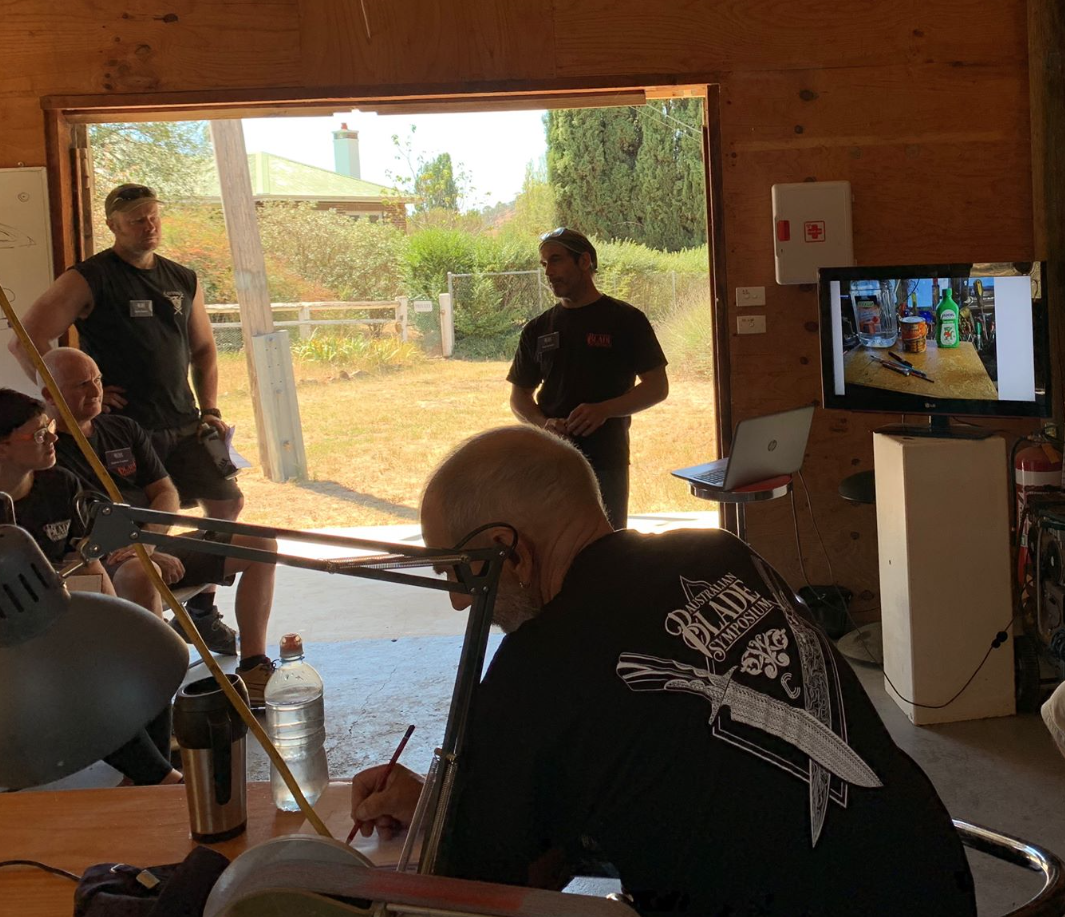
Paul talking etching, scrimshaw and patina finishes
Scrimshaw was i word i’d heard, but never knew what it meant. It is to draw with a needle (or sharp pointy implement) onto horn, bone or antler, create a dent, then fill the grooves with inks buffing away anything left on the surface until only the scratches have colour. Using templates or not, i definitely thing this would be a fun one to try, though i imagine it will have me review my glasses prescription a little more frequently.
Paul also passed around a series of steel samples, each with a different finish from a different etchant; mustard, tomato sauce, vinegar, stonewash etc which was interesting to be able to consider and compare them without needing to do it myself.
---
After Paul's talk, we decided to call it a weekend - having a long drive home.
If you ever get the chance to come to a future Blade Symposium, i can highly recommend it. The sessions are massively informative, but being able to talk to other makers in and around them is invaluable.
Big thanks to Karim and all at Tharwa Valley Forge and Cuppacumbalong Homestead, all the presenters who came from far and wide - I'll certainly being making the pilgrimage next year! The KAA did an great job pulling all of this together.
Recent Posts
-
Why Bed The Tang In Epoxy - Then Knock it OFF Again.
What is "Bedding the tang"? Bedding the tang means gluing a stick-tang blade into the handle block i …21st Mar 2025 -
Marble Leather - How to Dip Dye Veg Tanned Leather
This was my first experiment with hydrodipping or dip dying leather, and it came out pretty cool! I …14th Mar 2025 -
Make Burl Wood POP!
Staining wood with leather dye. or "How to make burl wood really pop". This technique really only wo …8th Mar 2025

